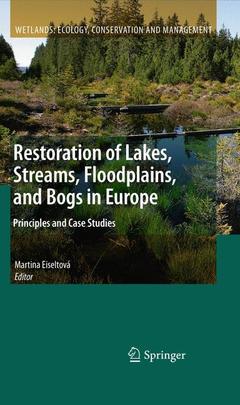Description
Restoration of Lakes, Streams, Floodplains, and Bogs in Europe, 2010
Principles and Case Studies
Wetlands: Ecology, Conservation and Management Series, Vol. 3
Coordinator: Eiseltová Martina
Language: English
Keywords
Danube; Phosphor; bog; development; ecosystem; environment; environmental protection; hydrology; mire; wetland
Restoration of Lakes, Streams, Floodplains, and Bogs in Europe
Publication date: 10-2012
374 p. · 15.5x23.5 cm · Paperback
Publication date: 10-2012
374 p. · 15.5x23.5 cm · Paperback
Restoration of lakes, streams, floodplains, and bogs in europe: principles and case studies (hardback) (series: wetlands: ecology,
Publication date: 08-2010
374 p. · 15.5x23.5 cm · Hardback
Publication date: 08-2010
374 p. · 15.5x23.5 cm · Hardback
Description
/li>Contents
/li>Comment
/li>
Despite our growing awareness of the vital role they play in the global environment, wetlands remain among the most endangered ecosystems on Earth and are still being destroyed and degraded at an alarming rate. This much-needed publication, which includes contributions from leading researchers and practitioners, presents a holistic perspective on the restoration of wetland ecosystems such as shallow lakes, streams, floodplains and bogs. Through the use of carefully chosen case studies, the authors examine European wetland restoration projects from Scandinavia to Bulgaria and from Ireland to Belarus, focusing on the lessons they can teach to a new generation of conservationists. As well as reviewing the sum of current knowledge on the subject, the text is a store of practical know-how, covering a wide range of conservation approaches and techniques. It analyzes the major problems in the field and identifies key principles for achieving sustainability in wetland restoration. The topics covered include: ? the role of wetlands in landscape functioning ? human interference with natural processes such as water and matter cycles and energy dissipation ? the impact of land use on global problems such as climate change, floods and droughts ? the role played by diversity in wetland functioning The work shows that without sustainable land use over the totality of their catchment areas, and without cohesive inter-agency cooperation, individual restoration projects will have a short life span. The balance between scientific background and practical restoration makes this book a valuable resource for scientists as well as wetland managers, decision makers and land use planners, as well as students of ecology, nature conservation and environmental protection.
Criteria for Sustainable Restoration of the Landscape.- The Evolution of Lakes and Wetlands.- Development of Aquatic Macrophytes in Shallow Lakes and Ponds.- Food Web and Trophic Interaction and Development.- Principles, Planning and Accomplishment of Lake Restoration Projects.- Restoration of Eutrophic Lakes by Sediment Treatment.- Restoration of Eutrophic Lakes by Phosphorus Precipitation, with a Case Study on Lake Gross-Glienicker.- Restoration of Lakes Through Sediment Removal, with Case Studies from Lakes Trummen, Sweden and Vajgar, Czech Republic.- Treatment of Overgrown Shallow Lakes Through Macrophyte Control: The Case Study of Lake Hornborga, Sweden.- The Stream and Beyond: Reinstating Natural Functions in Streams and Their Floodplains.- Floodplain Restoration of Large European Rivers, with Examples from the Rhine and the Danube.- Restoration of Streams in the Agricultural Landscape.- Effects of Drain Blocking on the Acrotelm of Two Raised Bogs in the Irish Midlands: A Quantitative Assessment.- Self-Recovery of Cut-over Bogs: Summary from Case Studies.- Restoration of Raised Bogs: Mechanisms and Case Studies from the Netherlands.- Restoration of Drained Mires in the Šumava National Park, Czech Republic.- Local and Global Impacts of Mire Drainage: An Impetus for Hydrology Restoration: Yelnia Mire, Belarus.
Offers a sound scientific background in wetland restoration ecology merged with practical experience of wetland restoration Clearly describes a wide range of methods, approaches and techniques for restoring different wetland types, covering shallow lakes, streams, floodplains, and mires Offers a new approach and well-defined criteria for the assessment of landscape sustainability Includes supplementary material: sn.pub/extras
© 2024 LAVOISIER S.A.S.




